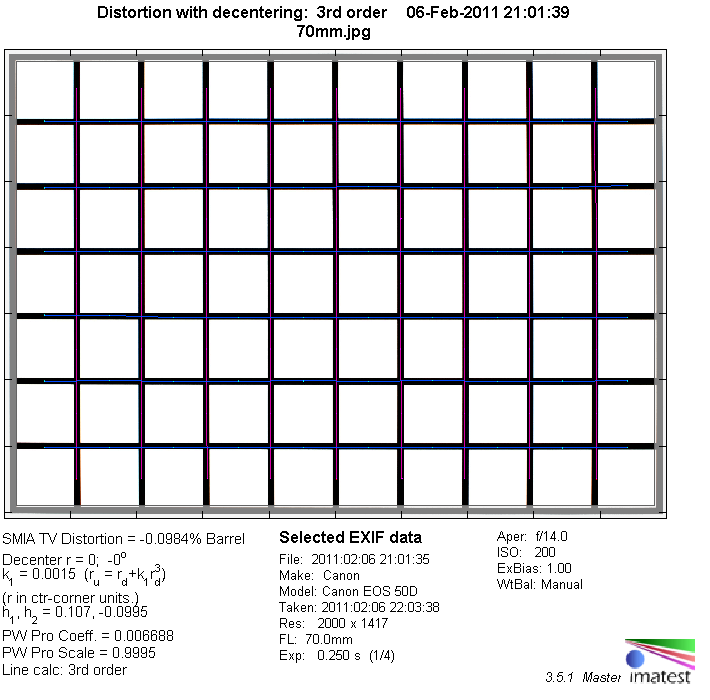|
Tamron AF 70-300mm f/4-5.6 SP Di VC USD (EOS) - APS-C Format Review / Lab Test - Analysis |
|
Lens Reviews -
Canon EOS (APS-C)
|
|
Page 2 of 2

Distortion
Used on an APS-C DSLR, the Tamron lens shows basically no distortion at 70mm and only slight pincushion distortion 200mm (0.7%) and 300mm (~1%). This is usually nothing to worry about from a field perspective.
|
Move the mouse cursor over the focal length text marks below to observe the respective distortion
|
| 70mm |
200mm |
300mm |

|
Vignetting
Thanks to the usual sweet spot behavior on APS-C DSLRs the light falloff at max. aperture is quite low. It is only slightly more pronounced at 300mm @ f/5.6 where you may see some hints of vignetting in critical scenes. However, you just need to stop down a little bit to solve this issue altogether.

MTF (resolution)
The resolution characteristic is impressively high on APS-C DSLRs. The center quality is already very good at 70mm @ f/4 followed by good borders. Stopping down pushes the center into excellent and the borders to very good levels. As expected there's a slight decrease in performance at 200mm and 300mm but the resolution remains very good across the image field even at the long end. It is also worth to mention that the contrast is comparatively punchy at 300mm - even at max. aperture. This is clearly a differentiator compared to the cheaper lenses in this class. The lens stays just slightly short of the mighty Canon EF 70-300mm f/4-5.6 USM L IS here.
Please note that the MTF results are not directly comparable across the different systems!
Below is a simplified summary of the formal findings. The chart shows line widths per picture height (LW/PH) which can be taken as a measure for sharpness.
If you want to know more about the MTF50 figures you may check out the corresponding Imatest Explanations
Chromatic Aberrations
Lateral chromatic aberrations (color shadows at harsh contrast transitions) are well controlled. The average CA pixel width at the image borders stays well below 1 pixel from 70-200mm and peaks at around 1.1px at 300mm. This isn't really field-relevant anymore.

Bokeh
The bokeh analysis has been taken from the full format review because the primary findings remain valid here of course.
The quality of the out-of-focus blur left us with rather mixed emotions unfortunately. It's fairly obvious that the lens does not like out-of-focus highlights. They show a distinct outlining effect with can be disturbing in certain situations. High-contrast transitions in the focus transition zone are fairly hard edged rather than smooth.
Here're some sample crops illustrating the issue.

 It is, of course, possible to get a pleasing bokeh when avoiding hard contrasts and fine-structure highlights:
It is, of course, possible to get a pleasing bokeh when avoiding hard contrasts and fine-structure highlights:

Sample Images
You can find some samples in the corresponding full format review of this lens.
VerdictThe Tamron AF 70-300mm f/4-5.6 Di VC USD performed fairly well in our full format test but it is a more desirable lens on an APS-C DSLR. The resolution figures are very high in the scope and that's, at least mostly, across the image frame. Lateral CAs are low and not objectionable from a field perspective. A nice aspect is the image contrast which is very high throughout the range including the critical 300mm setting. Based on what we've seen in the field the lens is also comparatively resistant against flare. The light falloff at max. aperture is just visible at 300mm @ f/5.6 but not really an issue otherwise. The quality of the bokeh can be rough in critical situations specifically regarding the highlight rendering. This may be somewhat unfortunate but the truth is that this aspect is generally a problem in this lens class.
The build quality is very high for a lens in this price class although it stays somewhat short of truly professional grade lenses. A real progress is Tamron's new USD ("Ultrasonic Silent Drive") - compared to the previous AF micro-motor generations it is both fast and near-silent and it supports FTM (Full-time manual override). Tamron's image stabilizer - it's called VC ("Vibration Control") - works fine although we won't really sign the claimed 4 f-stop efficiency. Either we had too much coffee during the field trip or it's actually closer to 2.5 f-stops.
The most interesting question is, of course, how it compares to the genuine Canon lenses in this range. The Tamron manages to stay a little ahead of the consumer-grade Canon EF 70-300mm f/4-5.6 USM IS but it doesn't totally reach the professional-grade Canon L variant (especially in terms of bokeh quality). Even so it represents an excellent value offer in the APS-C market.
|